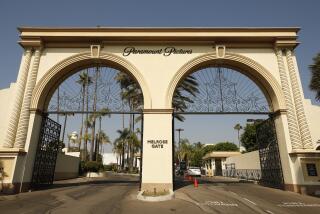THE ACQUISITION OF NWA : Analysts Believe Rejection of Bid Leaves Future of Pan Am Up in Air
- Share via
NEW YORK — Now that Pan American World Airways has been rebuffed in its attempt to take over Northwest Airlines, what’s next for the financially ailing carrier that once was a symbol of the United States as well known as Coca-Cola and Mickey Mouse?
Thomas G. Plaskett, chairman of Pan Am Corp., the airline’s parent company, is setting his sights high. “I am going to take every opportunity to maximize the value that is still inherent in Pan Am,” he said in an interview. “So I am going to keep my eyes open for opportunities.”
Plaskett, who has headed Pan Am for 18 months, feels that no quest is too big.
“As one of our directors said,” Plaskett said, “ ‘if it is a good business deal, there is a way to finance it,’ and I really believe that.”
When asked if plans could include deals with American Airlines or United Airlines, he replied with a chuckle: “Think big.”
Plaskett’s comments indicate the uncertainty that surrounds Pan Am.
Airline analysts and Pan Am management question whether the airline, having sold its most valuable assets--from its 57-story building in New York City and its hotel division to its lucrative Pacific routes--can generate sufficient cash to conduct its business or even survive.
They also wonder if the lack of domestic flights to feed its transatlantic routes will sound the death knell for the airline that initiated regularly scheduled flights between the United States and Europe and led U.S. airlines into the jet age. In this era of global mega-carriers, can Pan Am go it alone or must it merge with someone else?
‘Will Struggle Along’
Most observers predict that, barring another serious terrorist act against it such as the one that resulted in the crash of Flight 103 at Lockerbie, Scotland, or a worldwide recession that would drastically reduce leisure and business travel, Pan Am will be able to survive at least in the near term.
“Pan Am can be a marginal survivor,” said Timothy Pettee, airline analyst with Merrill Lynch, Pierce, Fenner & Smith. “I cannot see them prosperous and I can’t see them as a major industry player. But the ingredients are there for Pan Am to survive. They are not dead without Northwest.”
Edmund S. Greenslet, an airline analyst who heads ESG Aviation Services of Ponte Vedra Beach, Fla., agreed. “The future is pretty grim for Pan Am. I expect the company will just struggle along from crisis to crisis. That has been its history for a long time anyway. The most likely path for Pan Am is to continue to limp along, barely keeping body and soul together. They probably won’t go bankrupt. They probably won’t have to fold up their tent, but it is hard to see a healthy, viable, vibrant company at any time soon.”
Frank Spencer, a professor at the Transportation Center at Northwestern University in Evanston, Ill., said the only way Pan Am will be able to develop the route system it needs to compete is to combine with another carrier. “They never developed a domestic feed while everybody became affiliated in one way or another. They don’t have the financial resources to create any new hubs and if they did they could not get access because there is too much congestion to create any new hubs.”
The merger with Northwest would have been an ideal solution for Pan Am. For one thing there are few consolidation possibilities left. In the decade since deregulation, just about every airline has taken a partner. Pan Am is one of the only U.S. carriers that has not marched down the aisle during the merger frenzy of the last few years. It did merge with National Airlines more than 10 years ago, but that did not solve its problems.
Combination ‘Formidable’
Furthermore, a Pan Am-Northwest consolidation would have given both airlines assets they lacked. Pan Am would have gained domestic routes to feed into its Atlantic division. And it would once again have gained a presence in the Pacific. Northwest, on the other hand, would have been able to enter the European market. The two airlines had only eight overlapping routes. “The combination,” says Merrill Lynch’s Pettee, “would have created a very formidable competitor. It would have created the airline with the most balanced, and therefore the most powerful, route system in the United States.”
But, observers said, the Pan Am-Northwest combination would have been saddled with too much long-term debt, as much as $4.2 billion by some estimates. This would have required interest payments that would be too high for the combined entity and might have required the postponement of some of the planes that Northwest has ordered. The two carriers have the oldest fleets in the industry. In addition, there would also be great difficulties in integrating the two airlines, especially their labor forces.
Plaskett denied that such problems existed. He said neither carrier had a large pool of employees in the same city so that large-scale layoffs wouldn’t be required. Expected retirements by pilots would allow many younger pilots to move up the ladder quickly, squashing the seniority problems that existed in some other recent mergers.
Plaskett also scoffed at the charges that the high debt would be an obstacle. “We would not do the transaction if we did not think that the combined entities could not service their debt,” he said.
One thing is certain: The final chapter of Pan Am’s latest saga has yet to be written.
Plaskett has said for many months that the airline cannot remain stand alone forever. It must either be taken over by another carrier or by an independent investor. Or, if no suitor emerges, Pan Am must either go after another carrier or affiliate with a foreign airline.
Despite his pronouncements, Plaskett has received no nibbles. “He has seen that the other airlines really have no interest in buying Pan Am,” said one airline analyst who declined to be identified. “They are going to have to go out and buy another airline or see their business slowly erode over time.”
This analyst maintained that no other carrier, regardless of size, is immune to a takeover attempt by Pan Am. The airline could use the financing arranged for the Northwest takeover for any other attempt, even a carrier as large as United or American.
MAIN STORY: Part I, Page 1
More to Read
Inside the business of entertainment
The Wide Shot brings you news, analysis and insights on everything from streaming wars to production — and what it all means for the future.
You may occasionally receive promotional content from the Los Angeles Times.









